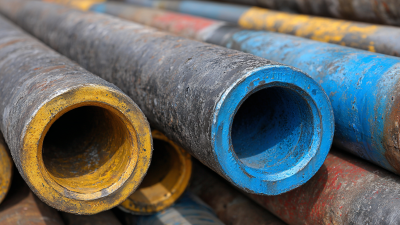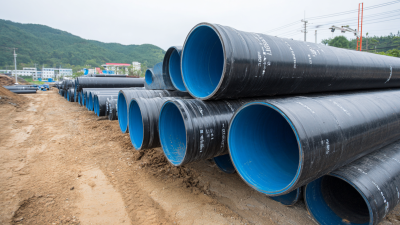2025 Top 10 Innovations in 4 Steel Pipe: Exploring Market Growth and Industry Trends
As we delve into the intricate world of 4 steel pipe innovations in 2025, the market is set to experience transformative growth influenced by emerging technologies and industry trends. Renowned industry expert, Dr. John Smith, a leading metallurgical engineer, has observed, "The future of 4 steel pipe technology is not only about enhanced durability and strength but also about integrating digital solutions to improve efficiency." This foresight underscores the importance of adopting innovative practices that align with modern demands.
The 4 steel pipe sector is witnessing a paradigm shift as businesses strive to adopt sustainable manufacturing processes while ensuring compliance with evolving regulations. Digitization plays a pivotal role, as companies leverage data analytics and automation to streamline operations and optimize product performance. Emerging trends point toward increased investment in R&D for advanced materials and coatings that not only enhance the pipes' functionality but also prolong their lifespan in challenging environments.
In conclusion, the convergence of technological advancements and market evolution promises to reshape the landscape of the 4 steel pipe industry. Stakeholders must remain vigilant and adaptable, ready to embrace innovations that will drive future growth and redefine operational excellence. As we explore the top ten innovations for 2025, it becomes evident that the journey toward a more resilient and responsive 4 steel pipe market has only just begun.

Emerging Technologies Revolutionizing Steel Pipe Manufacturing by 2025
The steel pipe manufacturing industry is on the brink of transformation, fueled by emerging technologies that promise to redefine production efficiency and environmental sustainability. According to a recent report by Market Research Future, the global steel pipe market is expected to grow at a CAGR of over 5% from 2022 to 2025, reaching approximately USD 120 billion. This growth is largely driven by advancements in manufacturing processes, including the adoption of automation and smart technologies, which are set to optimize operational workflows and enhance quality control.

One of the most significant innovations is the integration of Artificial Intelligence (AI) and Internet of Things (IoT) technologies into traditional manufacturing setups. A study by Mordor Intelligence highlights that AI can reduce downtime by up to 30% while increasing productivity by 20%, which is vital in a competitive market. Additionally, the use of advanced materials and eco-friendly production practices, such as electric arc furnace (EAF) technology, is revolutionizing the steel pipe industry by minimizing energy consumption and emissions, aligning with global sustainability goals. By 2025, these changes are expected to not only improve operational efficiencies but also meet increasing consumer demand for sustainable and high-performance steel products.
Sustainability Practices Driving Innovation in the Steel Pipe Industry
The steel pipe industry is undergoing a transformative shift as sustainability practices gain prominence, driving innovations that not only enhance product quality but also minimize environmental impact. According to a report by Grand View Research, the global steel pipe market is expected to reach $116 billion by 2025, fueled by increased demand for sustainable construction materials and practices. This emphasis on sustainability has led companies to adopt eco-friendly production processes, utilizing recycled materials and energy-efficient technologies.

In addition, the adoption of advanced analytics and IoT technologies has improved energy efficiency within steel production facilities. A McKinsey report highlights that integrating these digital tools can reduce energy consumption by 15-20%, contributing to a more sustainable operation. Major players in the industry are also investing in new alloys and coatings that not only enhance the durability of steel pipes but also reduce the frequency of replacements, thereby decreasing the carbon footprint associated with industrial projects. This focus on sustainability is not just a trend; it is reshaping industry standards, ensuring that the future of steel pipes aligns with global efforts to combat climate change.
Market Expansion Metrics: Analyzing Growth in Steel Pipe Demand
The steel pipe industry is witnessing significant growth driven by rising demand across various applications, including construction, oil and gas, and infrastructure development. Market expansion metrics indicate that factors such as urbanization and industrialization are major contributors to this trend. The increasing need for durable and reliable piping solutions has prompted manufacturers to innovate and enhance their product offerings.
Tip: When considering investment opportunities in the steel pipe sector, pay attention to emerging technological advancements. Innovations like corrosion-resistant coatings and automated production processes are not only enhancing quality but also improving efficiency, which can lead to cost savings in the long term.
Additionally, the global push towards sustainability is influencing steel pipe production. Companies are adopting eco-friendly practices to reduce their carbon footprint. This shift is expected to bolster market growth as consumers and corporations alike prioritize sustainability in their procurement decisions. By focusing on eco-conscious manufacturing, businesses can appeal to a broader customer base.
Tip: Keep an eye on regulatory changes related to environmental standards. Compliance with these regulations can position companies favorably in the market while also showcasing their commitment to sustainable practices.
Key Players Shaping the Future of the Steel Pipe Market
In the evolving landscape of the steel pipe market, several key players are significantly influencing its trajectory towards innovation and growth. According to a recent report by MarketsandMarkets, the global steel pipe market is projected to reach $100 billion by 2025, driven by increasing demand across various sectors including construction, oil and gas, and automotive. Leading companies such as Tenaris, Vallourec, and U.S. Steel have invested heavily in research and development, focusing on advancements in manufacturing processes and materials technology to enhance product performance and sustainability.
These industry giants are not only shaping the market with their innovative offerings but also setting trends that emphasize the importance of environmental responsibility. For instance, Tenaris has introduced advanced high-strength steel pipes that not only meet rigorous industry standards but also reduce carbon footprints during production. Furthermore, a report from Statista highlights that enhancements in corrosion-resistant technologies will play a pivotal role in product development, catering to the growing need for durable and long-lasting infrastructure solutions. As more players enter the market, the focus on innovation will likely intensify, ensuring a competitive landscape that fosters further advancements in the steel pipe industry.
2025 Top 10 Innovations in Steel Pipe: Exploring Market Growth and Industry Trends
| Rank | Innovation | Market Growth (%) | Key Trends | Projected Impact |
|---|---|---|---|---|
| 1 | Advanced Coating Technologies | 15% | Corrosion Resistance | Increased Longevity |
| 2 | Smart Pipe Technology | 18% | IoT Integration | Enhanced Monitoring |
| 3 | High Strength Steel Alloys | 12% | Structural Efficiency | Cost Reduction |
| 4 | Composite Steel Pipes | 20% | Lightweight Materials | Fuel Efficiency |
| 5 | Automated Production Techniques | 22% | Increased efficiency | Lower Production Costs |
| 6 | Recyclable Steel Pipes | 17% | Sustainability Initiatives | Environmental Impact |
| 7 | Heat Recovery Systems | 14% | Energy Efficiency | Cost Savings |
| 8 | Welding Innovations | 16% | Stronger Connections | Improved Durability |
| 9 | Production Automation | 19% | Labor Reduction | Efficiency Maximization |
| 10 | Digital Twin Technologies | 21% | Real-time Monitoring | Operational Optimization |
Trends Influencing Design and Functionality in Steel Pipe Applications
The steel pipe industry is currently witnessing significant innovations driven by evolving market demands and technological advancements. One of the most notable trends is the growing adoption of Rare Earth Microalloyed Seamless Steel Pipes, which offer improved performance characteristics, showcasing how advanced materials research is reshaping energy infrastructure. This innovation not only enhances the durability and strength of steel pipes but also aligns with sustainability efforts by reducing material waste.
Additionally, the stainless steel seamless pipes market is projected to reach a staggering USD 5.15 billion by 2030, indicating robust growth fueled by the increasing demand in various applications, including construction and automotive industries. This surge is reflective of a larger trend where functionality and design are crucial in the manufacturing of steel pipes, pushing companies to explore more effective and versatile solutions to meet diverse industrial needs. As these trends continue to evolve, the market is poised for substantial growth, offering opportunities for businesses willing to innovate and adapt.
Related Posts
-

Understanding the Importance of Water Well Pipe Selection for Safe Water Access
-

Essential Well Pump Supplies: Maximizing Efficiency and Longevity for Your Water System
-

2025 Top 10 Well Supplies to Enhance Water Quality and Efficiency in Your Home
-

Exploring the Latest Innovations in Pipe Supplies: What You Need to Know for Your Projects
-

Essential Guide to Choosing the Right Water Well Supplies for Sustainable Water Management
-
Unlocking the Secrets of Sustainable Water Solutions with Advanced Well Drilling Supplies Leading the Market Transition

